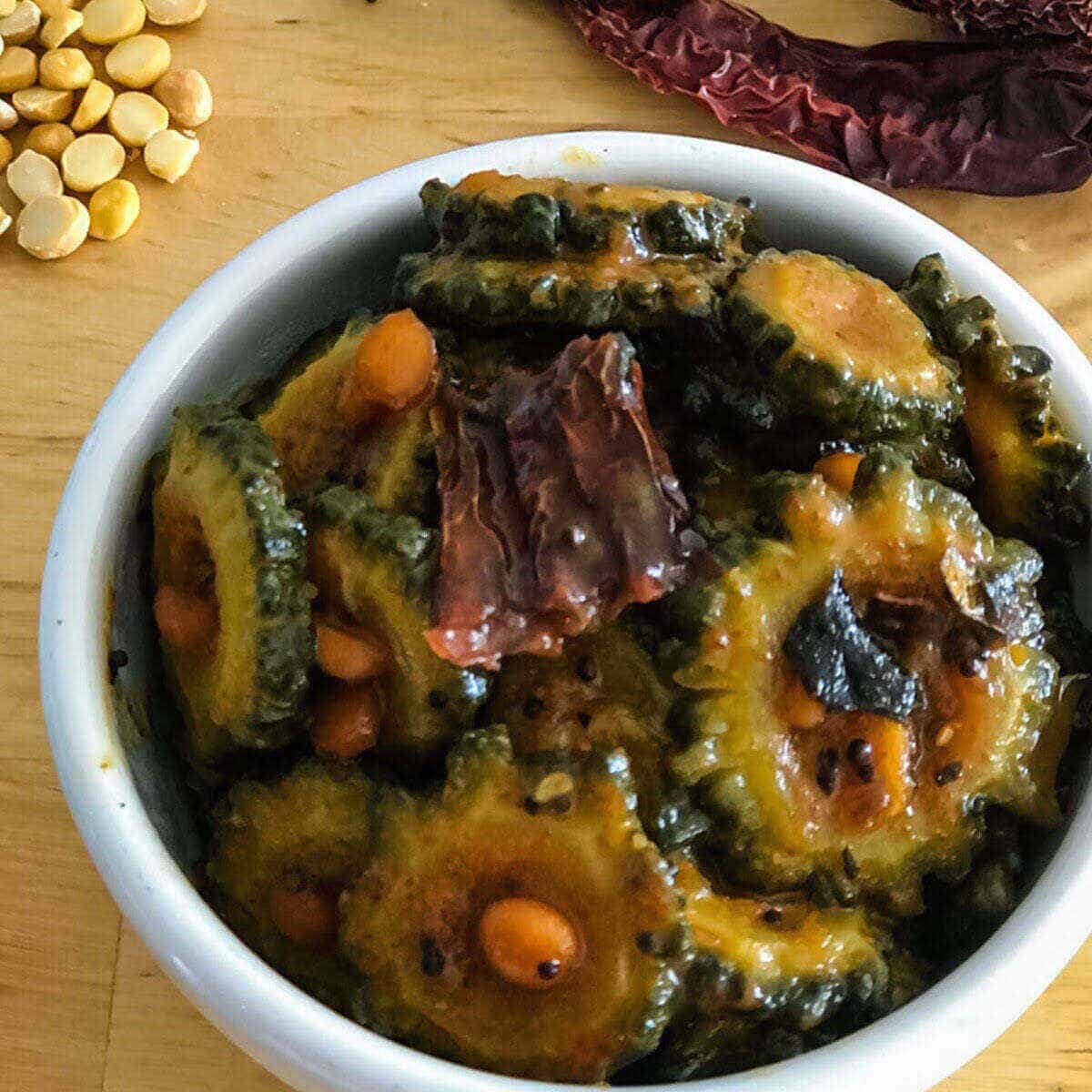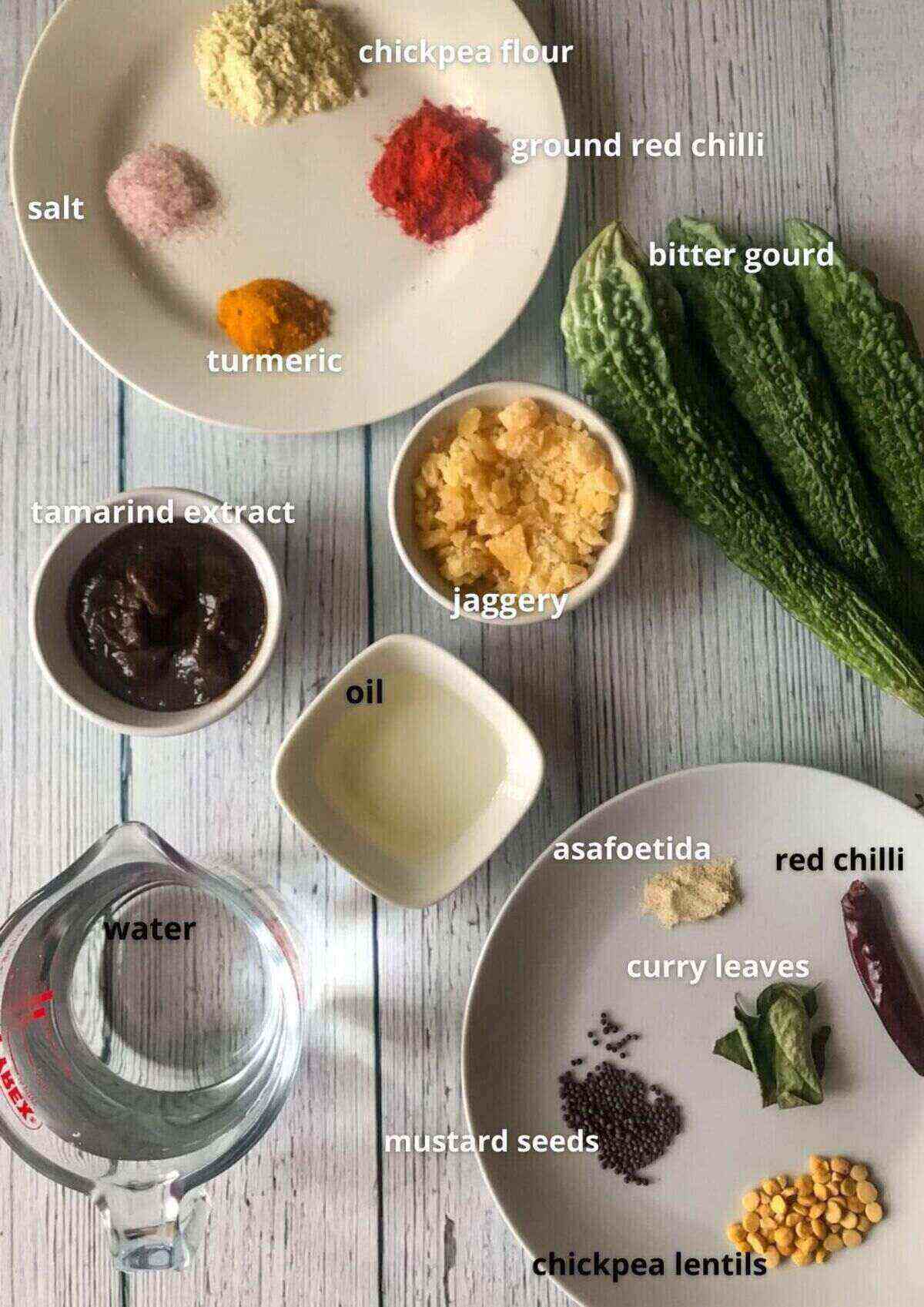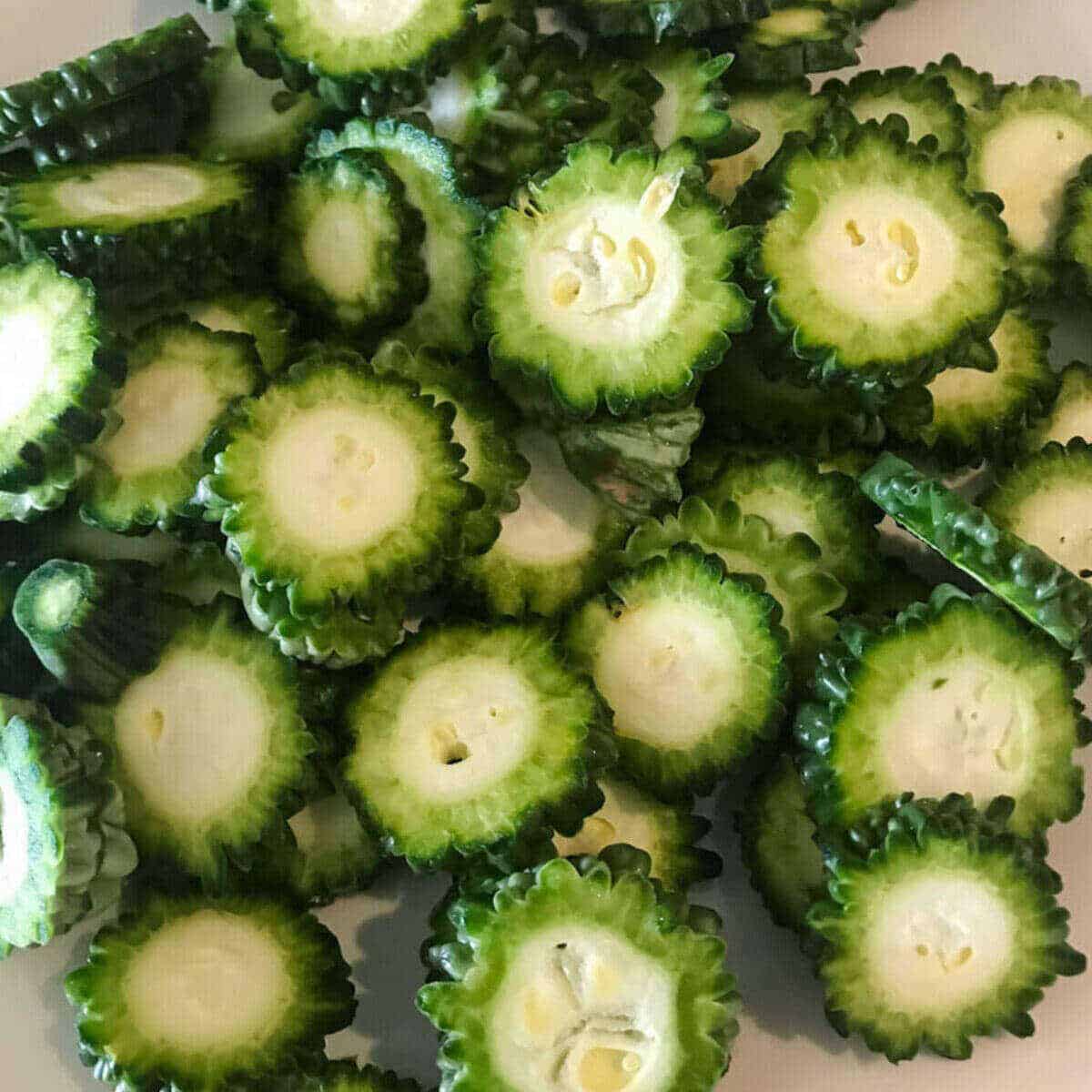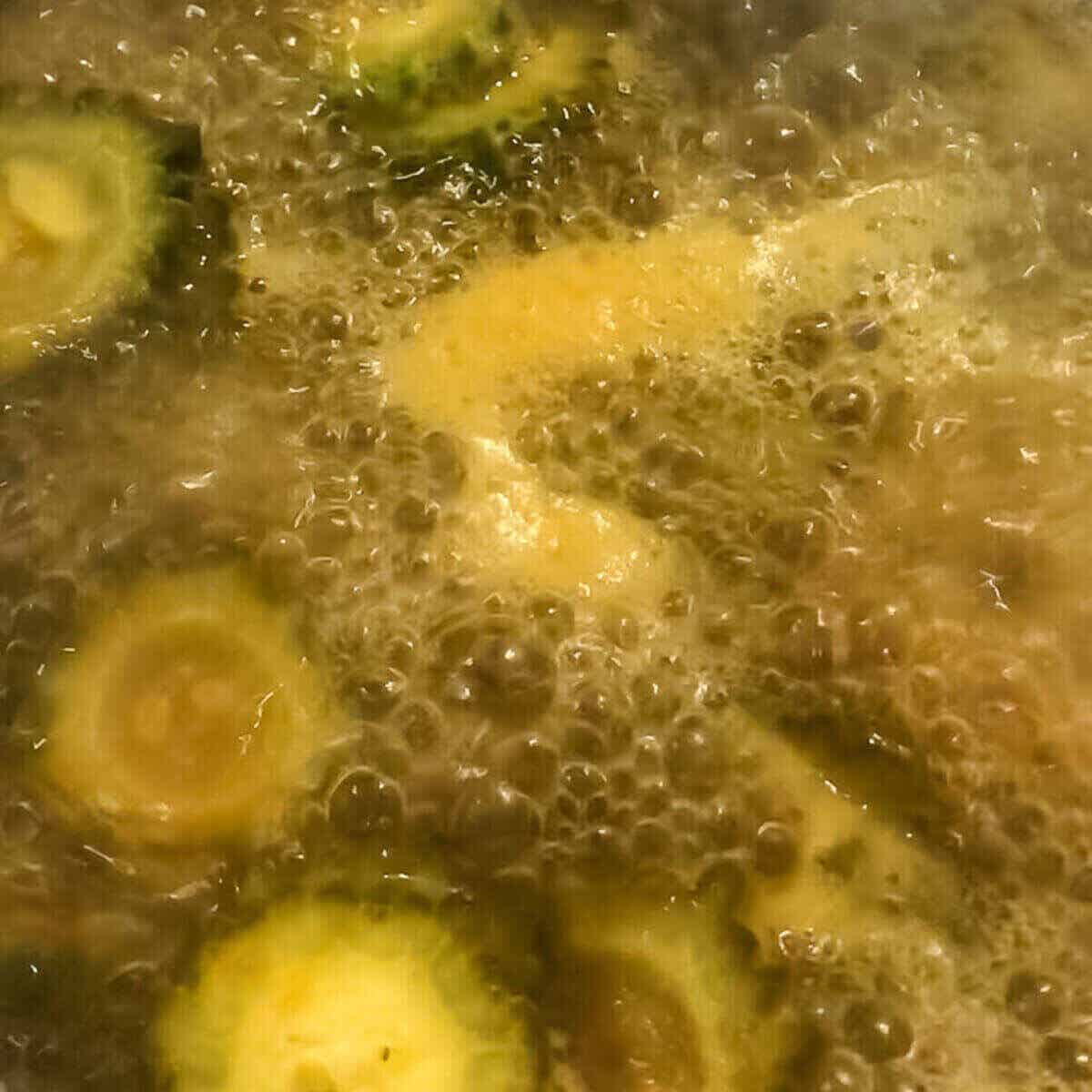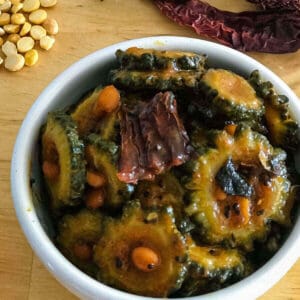Also known, in Hindi, as karela, and in Telugu as kakarakaya, bitter melon is respected in Ayurveda, the ancient science of healing and wellbeing for its medicinal and healing properties. What I love about this karela curry recipe is that it is not fancy, not dainty either! It is a traditional recipe from the state of Andhra Pradesh, India. This dish has been handed down to me my by mum who learned it from her mother-in-law who had it passed down to her. My grandfather an Ayurvedic Practitioner, loved this recipe. He was a big advocate of including kakarakaya, as we call this vegetable at home, in our daily diet. Growing up, I must admit that I did not like this vegetable at all! But of all the bitter melon recipes out there, this is my favorite! What is that one vegetable that you used to hate as a kid and now have learned to enjoy it? Do let me know in the comments below. Would love to hear about your experience.
Ingredients for bitter melon recipe
Check the recipe card below forquantities. Bitter Melon (Gourd): I use the dark green variety. Look for ones that are tender, firm, and with no yellow spots on them. Yellow spots indicate that they are not young and tender. Bitter gourds are available in most Indian/ Asian greengrocers. Jaggery: If you do not already know, jaggery is unrefined, natural cane sugar. It adds a lovely caramelly flavor to the dish….mmm, yum! You can get jaggery in Indian/Asian supermarkets in the form of blocks, cubes, or ready powdered. If you do not have jaggery, you may use soft, brown sugar instead. Tamarind Extract: The bitter gourd recipes that hail from South India most commonly use tamarind as the souring agent that helps balance the natural bitterness of the vegetable. In North India, dry mango powder (amchur) is most commonly used as the souring agent. I make tamarind extract at home. It is easy! Here is a video of how I make it. Or here is how to make tamarind pulp at home. Chickpea Flour (Besan): This helps to bind the juices and make a thick gravy. Ground Red Chili - I use mild and bright-colored Kashmiri red chili powder. You may use paprika. Asafoetida - Powdered asafoetida which is most commonly found in shops has gluten (plain flour) in it. There are some brands that sell the gluten-free version - look for those. Curry Leaves - You may use fresh leaves (available in most Indian greengrocers) or the dried variety (available in most health and wellness stores).
About bitter melon
Bitter melon or bitter gourd as it is also called belongs to the gourd family and is closely related to courgettes, cucumbers, and squash - difficult to relate to that right, considering how bitter it is?! This bumpy, lumpy, odd-looking veggie has been hugely respected for its medicinal properties long before it became an ingredient in recipes! Bitter squash, karela, balsam pear, bitter gourd, and goya are some of the other names for this vegetable.
How to cook bitter gourd to remove its bitterness?
Bitter gourd can be a daunting vegetable to consume. However, because of its many health benefits, It is worth all the efforts to make it easy to consume! In this recipe, the bitterness is reduced and balanced in these ways:
boiling the gourd pieces in salted water with tamarind - this step will draw out the bitter juices and balance with the sourness from the tamarind. adding jaggery, spices, and chickpea flour helps further balance the bitterness of this vegetable.
Here are a few other ways to reduce the bitterness of the gourd (not for this recipe, though)
- Sprinkle some salt over the chopped gourd pieces and let them sit for 10 minutes. Rinse in water and then squeeze out the water.
- Chop the gourd and soak in buttermilk for 10 minutes. Drain, rinse and squeeze out the water.
- Combine and cook with other sweet-tasting vegetables such as carrots, potatoes, and butternut squash.
Instructions
Now that we have all the ingredients, let us go to the kitchen and make this easy, delicious side dish, shall we?
STEP 1: Start by prepping the bitter gourd. We are using 3 tender and firm (weighing approximately 200g) gourds. Wash and cut each gourd into rounds - about ½ cm thick. Do note that we are not peeling the skin nor are we discarding the pith.
STEP 2: In a saucepan, bring 1 and ¼ cups (300 ml) of water to a boil.
Add the salt, turmeric, and tamarind extract.
Add the chopped gourds. Cook till the vegetable is soft, but not fully cooked. This will take 5-7 minutes.
Once cooked, drain (discard the water) and keep aside.
STEP 3: Now let’s make the curry.
Heat oil in a heavy-bottomed frying pan on medium-high heat. Add the chickpea lentils. When the lentils start turning brown, add the rest of the spices - mustard seeds, red chili, asafoetida, and curry leaves. Wait till the mustard seeds begin to splutter.
STEP 4: Add the bitter gourd pieces (which we had boiled and drained), jaggery, and ground red chili. Stir.
Almost immediately you will notice that the jaggery begins to melt and caramelize.
Reduce the heat from medium-high to medium-low and let the jaggery melt. The melting jaggery will combine with the juices from the bitter melon to become a syrup and coat the vegetable.
This step will take 3-4 minutes. Bear in mind that the heat should be medium-low.
Note: The syrup that is made by melting jaggery and the moisture from the gourd pieces, should be sufficient to fully cook the gourd. If at this point you find that the dish is dry and the spices are sticking to the bottom of the pan, add 1-2 tablespoons of water.
STEP 5: Now sprinkle the chickpea flour evenly over the gourd. Mix gently. Cook for another 2-3 minutes on low heat. Turn off the heat and serve.
The flour will help bind the syrup, juices, and spices and coat the gourd evenly, giving the curry a lovely, thick texture.
Serving suggestions
At home, I like to serve this kakarakaya curry (kakarakaya = bitter gourd in Telugu language) with hot rice, ghee, dal, and this Indian yogurt sauce. This curry tastes good with flatbread as well - try it with this gluten-free naan.
Pro Tips and Notes
Cut the gourd in even size, approximately ½ cm thick. Cutting them too thin will turn them into mush and ruin the texture of the dish.
To avoid overcooking and turning the vegetable into mush, do not cover the pan when boiling the gourd pieces.
Begin by keeping the heat at medium-high. This will help fry the spices to a golden brown and evenly.
After adding the jaggery, turn the heat down to medium-low so as to not burn the jaggery.
Why you will love this bitter gourd recipe
I find sweet, sour, and spicy dishes such as this one and this vegan stew so rich in depth and flavor. They hit so many notes at the same time and create perfect harmony in my palate!
These are the reasons why you will love it:
📌The dish looks so attractive.
📌The bitterness of the gourd is beautifully balanced with sweet, sour, and mild spices.
📌This recipe is a great way to give this intriguing, under-appreciated, yet healthy vegetable to your child.
📌The recipe is easy to make and tastes delicious!
If you have made this unique bitter melon recipe, please take a moment to leave a comment and /or a rating below. This will make me super happy and motivate me to create more good content for you! xx Padma
📖 Recipe
Disclosure: The nutritional information is calculated using an online calculator and is based on available ingredients and preparation. It should not be considered a substitute for a professional nutritionists’ advice. Changing the quantities and cooking technique will alter the nutritional calculations.
